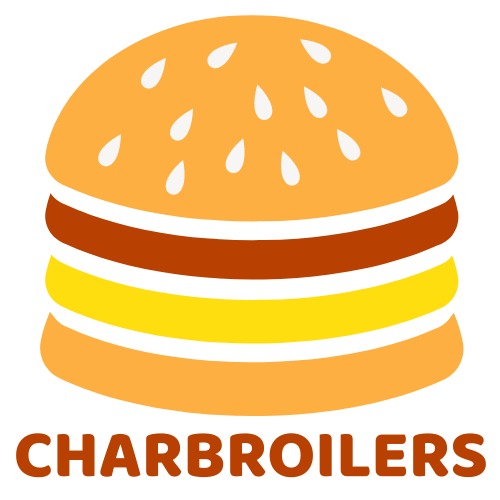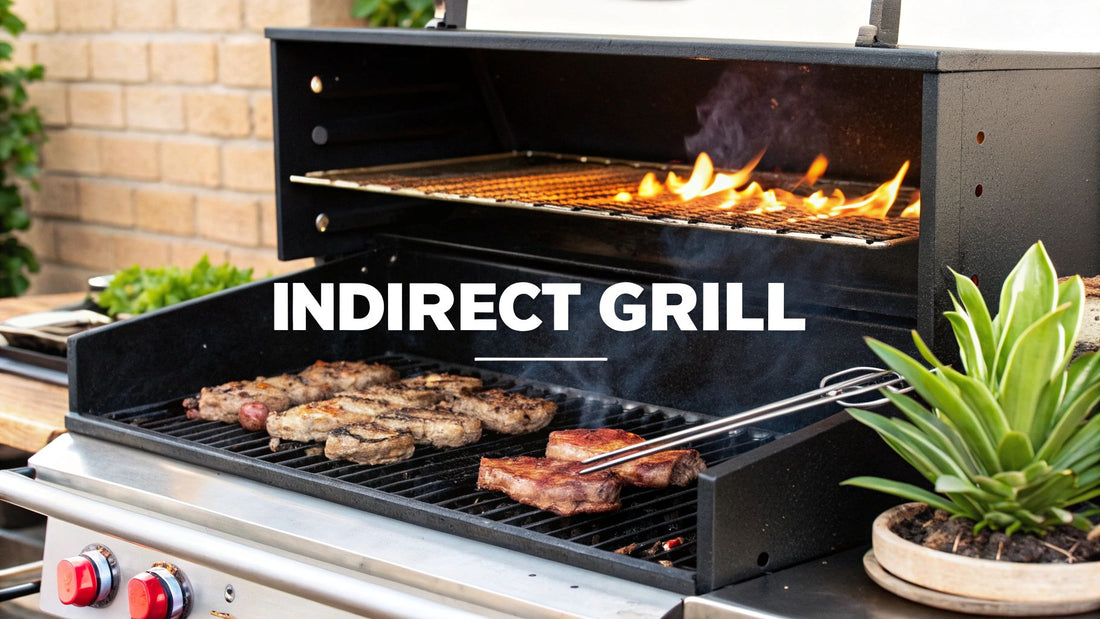
Master Indirect Cooking on Grill Tips & Techniques
Share
Let's get one thing straight: indirect cooking on a grill is so much more than just shuffling food away from the fire. This is a game-changing culinary strategy that turns your commercial charbroiler into a powerhouse convection oven. What you're doing is using circulating hot air to cook, which results in unbelievably tender, perfectly cooked proteins every single time—without that dreaded charred exterior.
Why Indirect Grilling Is a Chef's Secret Weapon
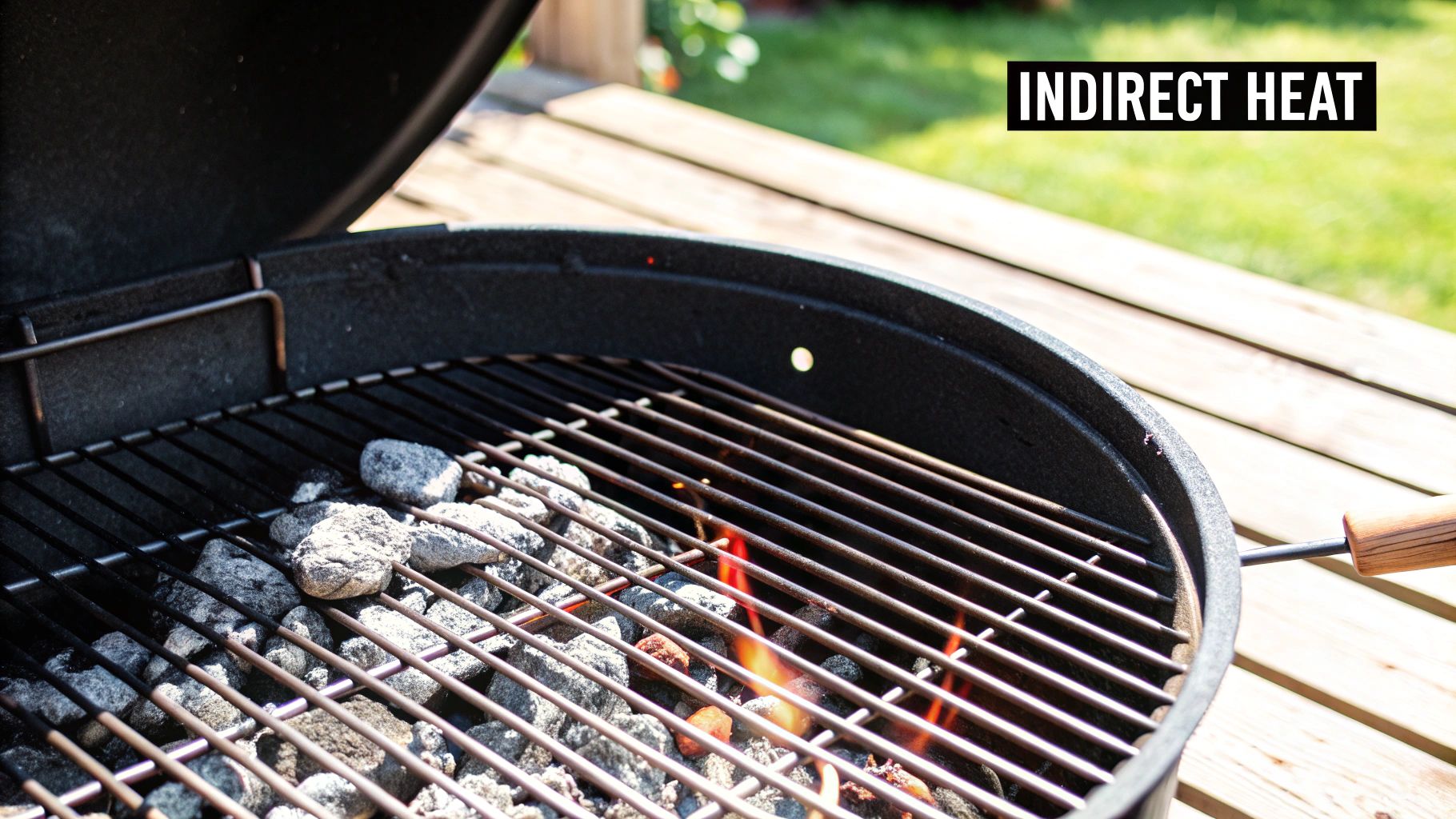
In a high-stakes professional kitchen, consistency is king. Indirect grilling gives you a level of precision that you just can't get with direct, high-heat cooking, especially when you’re dealing with larger or more delicate menu items. It’s my go-to method for making sure a thick-cut pork chop or even a whole chicken cooks all the way through to the perfect internal temp without burning on the outside.
This technique is less about brute-force searing and more about a gentle, all-encompassing heat. Think of it like roasting, but with the massive bonus of that authentic smoke and grill flavor your customers line up for. From a business perspective, this approach is brilliant because it drastically cuts down on food waste by preventing overcooking—a crucial win for managing kitchen costs on pricey proteins.
The Power of Convection and Control
At its heart, indirect grilling is about setting up a two-zone fire on your charbroiler. You’ll have one side with direct heat and another side with no direct heat at all. The food goes on the cooler side, you close the lid, and voilà. This simple setup allows hot air to swirl around the food, cooking it evenly from every angle.
Once you master this, you open up a whole new world of menu possibilities beyond the usual burgers and steaks. For a restaurant, this is huge. It means you can confidently add complex, slow-cooked showstoppers to your menu.
- Large Proteins: Think brisket, pork shoulder, and racks of ribs that become so tender they practically fall off the bone.
- Delicate Foods: You can perfectly cook fish fillets and tricky vegetables without them disintegrating on the grates.
- Enhanced Flavor: It creates the ideal environment for infusing deep, smoky flavors using wood chips or chunks.
A Time-Honored Technique for Modern Kitchens
Indirect grilling isn't some new fad. This is a classic culinary technique that’s been central to barbecue traditions around the globe for decades. It’s always been the key to tackling big cuts like brisket, whole chickens, or ribs—items that need long, slow cooking without getting torched on the outside. You can actually explore more about the evolution of grilling techniques and its impact on the market.
Pro Tip: I always place a drip pan with a little water or broth on the indirect side. It not only catches drippings for amazing sauces later but also adds moisture to the cooking environment, which is the secret to keeping proteins from drying out during those long cooks.
This reliable technique is the magic behind so many signature dishes that create loyal customers. It empowers chefs to pump out consistently moist, flavorful, and perfectly cooked food, service after service. Getting the hang of indirect cooking on a grill isn't just another skill—it's a foundational technique for any serious grilling operation.
Choosing the Right Commercial Charbroiler
Your equipment is the heart of your operation, especially when it comes to mastering techniques like indirect grilling. In a high-pressure commercial kitchen, you need more than just a grill that gets hot. You need precision, unwavering reliability, and the right features to consistently execute your menu. The charbroiler you choose is a direct investment in your ability to control heat and deliver amazing food.
Let's walk through the pros and cons of the different professional charbroilers out there—gas, infrared, and electric—and see how each one stacks up for the specific demands of indirect cooking.
Gas Charbroilers: The King of Control
When you need to create perfect heat zones for indirect cooking, nothing beats a gas charbroiler. Honestly, they are the undisputed champs for this kind of work.
What makes them so good is their design. Most have multiple, independently controlled burners. This means you can fire up the burners on one side for that high-heat sear, while leaving the other side completely off to create a stable, cooler zone for finishing. It's simple, but incredibly effective.
This level of control is everything when you're in the weeds. A line cook can get a beautiful crust on a steak over the flames, then slide it to the cool side to gently bring it to a perfect medium-rare. It all happens on one piece of equipment, which is a massive win for workflow.
The market backs this up. Gas grills dominate globally with a 55.2% market share, and a big reason is that this multi-zone capability makes indirect cooking so straightforward. With the market valued at USD 5.28 billion and still growing, it's clear that chefs and home cooks alike want this versatility. You can see the full breakdown by checking out the latest market analysis from Grand View Research.
A Note from Experience: I've run kitchens where the gas charbroiler was the MVP on the line. Being able to set up a reliable two-zone fire in seconds during a chaotic dinner rush is a game-changer. It means less stress for your cooks and, more importantly, consistent food for your guests.
Infrared and Electric Options
While gas models are my go-to for zone control, other types of charbroilers have their own unique strengths, especially when you think about different ways to use indirect cooking on a grill.
-
Infrared Charbroilers: These things are famous for their absolutely blistering, intense heat. While creating a true cool zone right on the unit is trickier, they are incredible for the "reverse sear" method. You can cook a thick-cut pork chop low-and-slow in a convection oven, then hit it on the infrared broiler for a few moments to create a flawless, sizzling crust right before it goes out to the customer.
-
Electric Charbroilers: Don't sleep on modern electric models. Many now come with independent heating elements that let you create a two-zone setup that's surprisingly similar to a gas grill. They're a fantastic solution for kitchens that can't run a gas line or for mobile operations like food trucks that need flameless cooking options.
To help you sort through the options, I've put together a quick comparison table.
Commercial Charbroiler Comparison for Indirect Cooking
This table breaks down the key features of each broiler type to help you pinpoint the best fit for your kitchen's indirect grilling needs.
| Broiler Type | Heat Control | Best For | Key Advantage |
|---|---|---|---|
| Gas | Excellent (Independent Burners) | Creating distinct hot and cool zones for classic two-zone grilling. | Unmatched flexibility and speed in setting up indirect heat. |
| Infrared | Intense, focused heat | The "reverse sear" technique; getting a final, powerful crust. | Incredible searing power and extremely fast pre-heating. |
| Electric | Precise (Independent Elements) | Kitchens without gas lines; flameless cooking environments. | Excellent temperature precision and consistency. |
Ultimately, picking the right charbroiler comes down to your menu, your kitchen's workflow, and the volume you're dealing with. An investment in the right equipment is really an investment in your food's quality and your kitchen's success.
To dig even deeper, be sure to check out our guide to commercial charbroilers for your restaurant. It’ll walk you through everything you need to know.
How to Create a Perfect Two-Zone Fire
If you want to master indirect cooking on your charbroiler, the two-zone fire is the absolute bedrock. It’s a simple, brilliant technique that hands you total control by splitting your grill into separate hot and cool zones. Nailing this setup is your ticket to consistent, professional-grade results every single time.
The real beauty here is the versatility. You get that perfect, high-heat sear on the direct side for incredible flavor and color, then you can slide the food over to the cooler, indirect side. This lets it finish cooking gently with circulating hot air, preventing a burnt exterior while the inside slowly comes up to the perfect temperature.
This image shows the classic two-zone fire on a charcoal grill, but the principle is the same no matter what you're cooking on.
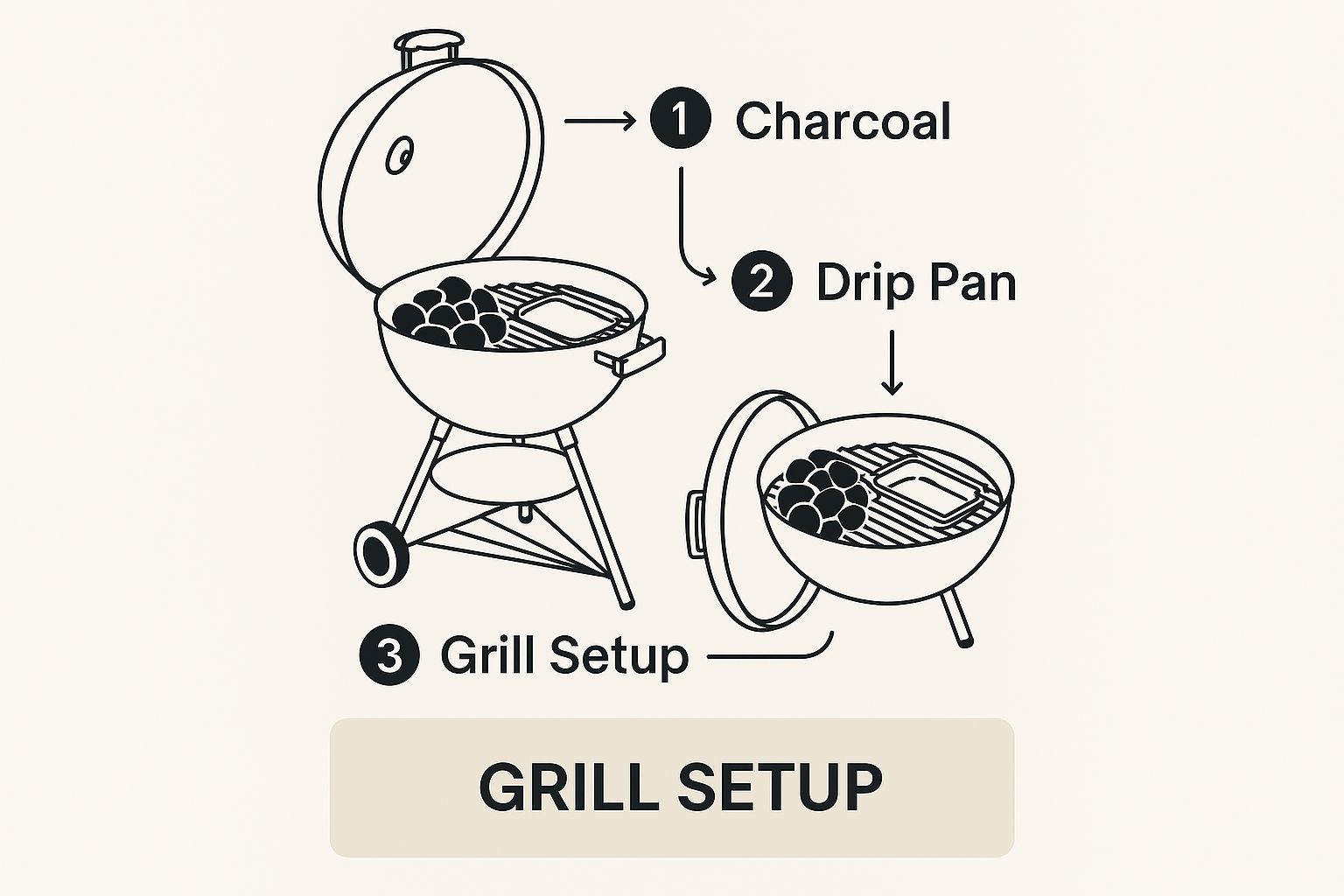
As you can see, the idea is to separate your direct heat source from the area where the food sits, creating a convection-like cooking environment under the lid.
Setting Up Zones on Commercial Charbroilers
How you build these zones comes down to your equipment. In a commercial kitchen, this is where having the right unit really pays off.
-
Gas Charbroilers: This is by far the easiest way to do it. Just crank the burners on one side of your grill to high or medium-high to create your direct zone. Leave the burners on the other side completely off for your indirect zone. It’s fast, precise, and a lifesaver during a busy service.
-
Charcoal Charbroilers: This takes a bit more hands-on effort, but the flavor payoff is incredible. Once your charcoal is lit and glowing, simply rake all the hot coals over to one side. This gives you a powerful direct heat zone right above the coals and a much cooler, indirect zone on the empty side.
One of the most critical—and most overlooked—parts of this setup is the drip pan. Place a simple aluminum pan on the empty side of the grill (your cool zone), right under where your food will be. It does more than just catch drippings; filling it with water or broth introduces moisture into the cooking environment, which is absolutely essential for keeping large cuts of meat from drying out during a long cook.
The Drip Pan’s Dual Purpose
That drip pan isn't just for moisture. It serves another vital function: preventing flare-ups. As fat renders out of proteins like chicken wings or a big pork shoulder, it has to go somewhere. If it drips directly onto hot coals or flames, it ignites, coating your food in that bitter-tasting soot. The drip pan catches that rendering fat, ensuring you get a clean, smoky flavor instead of a burnt one.
By mastering the two-zone fire, you transform your charbroiler from a basic grill into an incredibly versatile cooking machine. For more ideas on maximizing your equipment's potential, check out our guide on getting fired up about commercial charbroilers. It's a fundamental skill every chef who's serious about grilling needs to have in their back pocket.
Mastering Temperature and Smoke Infusion
When you're cooking indirect on a commercial charbroiler, consistency is everything. It's the whole game. The fastest way to ruin a great cut of meat is with wild temperature swings. Nailing a stable, predictable cooking environment is where the real pros separate themselves from the amateurs.
It all starts with knowing your target temperatures. For those classic low-and-slow barbecue legends like brisket or a pork shoulder, you're aiming for that sweet spot between 225°F and 250°F. But if you're roasting a whole chicken and chasing that perfectly crisp, golden-brown skin, you'll need to dial it up to a much hotter, steadier 350°F to 375°F.
Once you know your number, locking it in is a matter of technique. On a gas charbroiler, you’ll make tiny adjustments to the lit burners, nudging the flame up or down to hold your temp. If you're working with charcoal, it's all about airflow. Opening the intake and exhaust vents feeds the fire more oxygen and raises the heat; closing them down starves it a bit and brings the temperature down.
Elevating Flavor with Authentic Smoke
After you've got your heat stabilized, it's time to add that next dimension of flavor: real, authentic smoke. This is what takes good barbecue and makes it unforgettable. The secret is picking the right wood, because each type brings its own personality to the party.
- Hickory and Mesquite: These are the heavy hitters. They deliver a bold, assertive smoke flavor that’s perfect for standing up to big, beefy flavors like brisket or pork.
- Oak: I think of oak as the perfect middle ground. It’s got a solid, medium smoke flavor that's less aggressive than hickory but has more punch than the fruitwoods. It’s a fantastic all-rounder.
- Apple and Cherry: These fruitwoods bring a much milder, sweeter, and more delicate smoke to the table. They’re my go-to for anything that could be easily overpowered, like poultry, fish, and certain cuts of pork.
For long cooks, you'll want to use wood chunks for a steady, long-lasting smolder. If you're doing something quicker, a handful of wood chips will do the trick. Just place them right on the hot coals (for a charcoal unit) or in a designated smoker box (on a gas grill). And please, don't soak your wood! That just creates a bunch of dirty steam, not the clean smoke you're after.
The real mark of a pitmaster is the ability to produce "thin blue smoke." It’s a faint, almost invisible wisp of smoke that tells you the fire is burning cleanly and efficiently. This is what imparts the best, purest flavor. Thick, white, billowing smoke is a sign of a choked fire, and it will make your food taste bitter and acrid.
Your Charbroiler and Flavor Infusion
The specific charbroiler you're using will definitely influence how you manage your heat and smoke. To find the perfect unit for your restaurant's needs, we offer a wide selection of commercial charbroilers, including infrared, gas, and electric models. Each is built to deliver professional-grade results, but they all have their own quirks and advantages.
To get a better feel for how different units handle these crucial tasks, you should check out The Ins and Outs of Commercial Charbroilers. It's a great resource for figuring out which style is the best fit for your kitchen and menu. Once you get these elements dialed in, you're not just grilling anymore—you're using your charbroiler like a true precision instrument for building incredible flavor.
Signature Dishes Using Indirect Heat
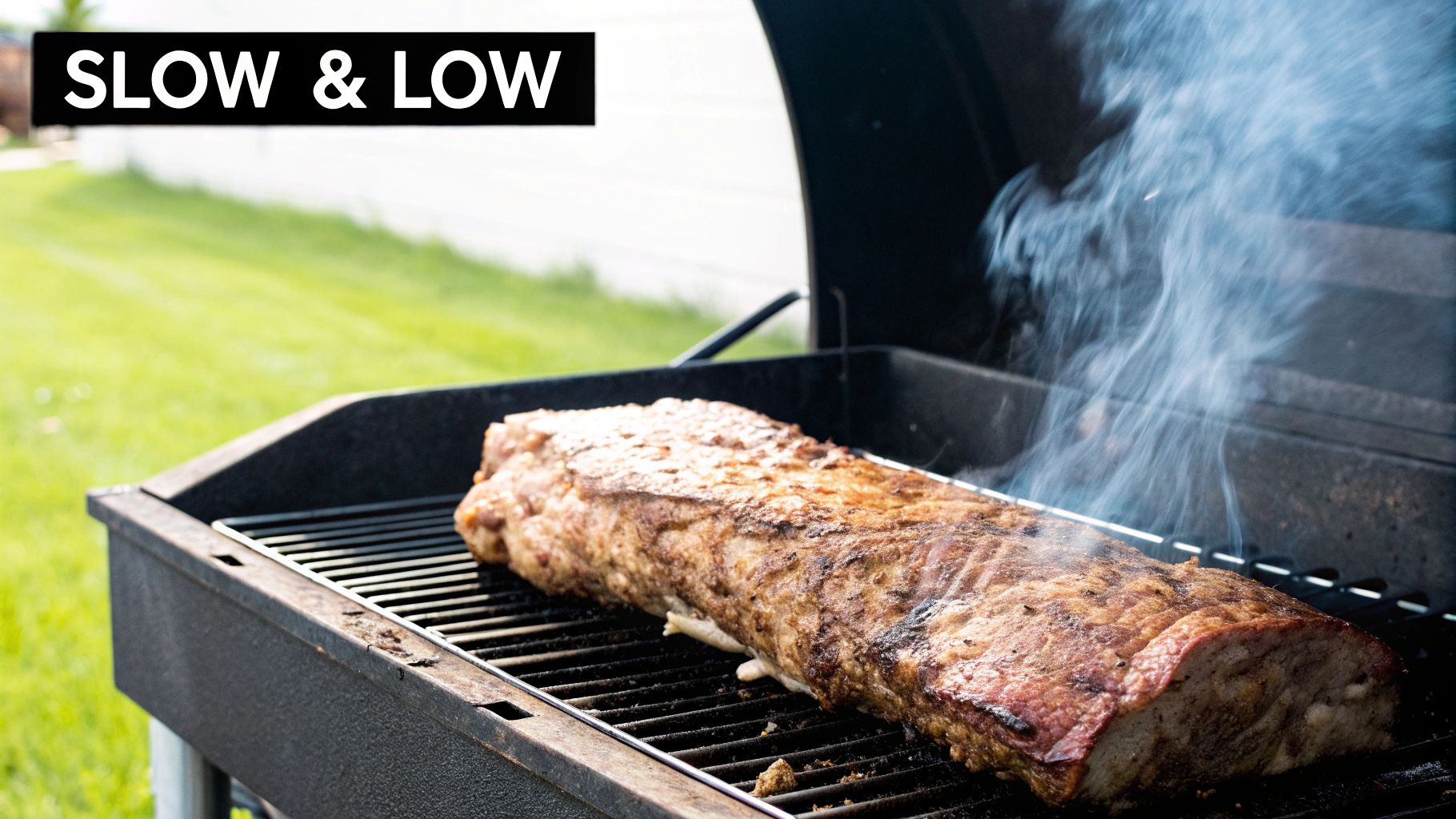
Alright, you’ve got the theory down. Now for the fun part: turning that knowledge into menu items that people will be talking about for weeks. This is where we move past the basic setup and dive into how indirect cooking on a grill transforms everyday ingredients into genuine signature dishes, even in the middle of a chaotic dinner rush.
Indirect heat is where large-format proteins really come alive. Think about pulling a fall-apart tender pork shoulder for pulled pork right off the broiler, or a whole beer-can chicken with that impossibly crispy skin and ridiculously juicy meat. These are the showstoppers that indirect heat makes not just possible, but consistently perfect.
Large Format Proteins Perfected
When you're dealing with big, tough cuts like a pork shoulder or a beef brisket, a slow and gentle indirect setup isn't just a suggestion—it's essential. It's the only way to give all that connective tissue the time it needs to break down and render, turning what started as a tough piece of meat into something succulent and packed with flavor.
Let's take a classic 10-pound pork shoulder. You’ll want to get it settled on the cool side of your charbroiler, holding a steady cooking temperature around 225°F. The magic happens when the internal temp hits between 195-203°F, a process that can take anywhere from 8 to 12 hours. This low-and-slow game is exactly what delivers that signature shredded texture.
A whole roasted chicken is another guaranteed crowd-pleaser. For this, I like to run the broiler a bit hotter, closer to 350°F, to make sure the skin gets beautifully crisp while the meat cooks evenly. Just place it on the indirect side and cook until the thickest part of the thigh hits a food-safe 165°F.
Expanding Beyond the Main Course
Don't think indirect cooking is just for meat. It’s also your secret weapon for creating unforgettable side dishes that soak up all that incredible smoky flavor from your charbroiler.
Imagine offering a side of smoked mac and cheese. Just prepare your recipe as you normally would, pour it into a cast-iron skillet or a foil pan, and set it on the indirect side of the grill. The circulating smoke will infuse the cheese with a depth of flavor you just can't replicate in an oven.
The same goes for a medley of roasted root vegetables—carrots, parsnips, potatoes. Toss them in a little oil and your favorite herbs, spread them out on a tray, and let them cook on the cool side until they're perfectly tender. The gentle heat caramelizes their natural sugars without burning them to a crisp.
The versatility of indirect grilling plays a huge role in the commercial hospitality sector. Barbecue restaurants, which have seen a massive surge in popularity, rely heavily on this method. In the U.S. alone, the restaurant industry, with over one million locations, was projected to hit USD 899 billion in revenue. A significant portion of this is driven by barbecue concepts that use indirect cooking to produce large volumes of slow-cooked meats, perfecting flavor and texture for their customers. Discover more about the growth of the barbecue market.
No matter what you're cooking, having the right gear is what ties it all together. Our wide selection of commercial charbroilers is built for exactly these kinds of applications. Whether you need the precise zone control of a gas charbroiler for classic barbecue, the high-heat finishing power of an infrared unit, or the steady convenience of an electric model, we have the perfect charbroiler to help you execute these signature dishes flawlessly in your restaurant.
Your Indirect Grilling Questions Answered
Even the most seasoned chefs hit a wall when trying a new technique for the first time. When it comes to getting the hang of indirect cooking on a grill, I see the same questions pop up again and again. Let's tackle them head-on so you can troubleshoot like a pro on your commercial equipment.
One of the biggest anxieties is about flare-ups. While indirect heat dramatically cuts them down, they can still happen, especially when you’re going for that final sear. The fix is surprisingly simple: keep the lid closed. When you slide food over the direct heat to get that char, closing the lid chokes off the oxygen supply. This tames the flames while still letting the fat render out beautifully.
Another common challenge is getting that perfectly crispy skin on something like chicken wings without torching them. I've found the best method is to cook them almost all the way through on the indirect side at a pretty high temp, say 425°F (218°C). Then, for the last couple of minutes, move them directly over the flames for a quick, covered sear. The skin crisps up in a flash.
Can You Use an Electric Charbroiler for Indirect Cooking?
Yes, you absolutely can, and they can be fantastic for it. Gas and charcoal seem to get all the glory, but many modern commercial electric charbroilers are designed with indirect cooking in mind.
The key feature to look for is independent heating elements. This is what lets you create that essential two-zone fire. You just crank up the elements on one side for your direct heat and leave the other side completely off (or on its lowest setting) for your indirect zone. Always give your manufacturer's guide a quick read to make sure your unit is built for this.
Key Takeaway: The "reverse sear" is where indirect cooking really shows its power. You cook your protein low and slow on the indirect side until it’s just a few degrees shy of your target temp. Then, you blast it over the direct, high heat for a minute or two to build that incredible crust. It gives you surgical control over the final doneness.
How Do You Keep Food from Drying Out?
Moisture management is the name of the game, especially during those long, slow cooks. Your number one tool here is a simple drip pan. I like to place a pan filled with water, broth, or even some apple juice on the indirect side of the grill, right under the grates. This creates a steamy, humid environment that works wonders to keep proteins from drying out.
Beyond that, good prep goes a long way. Using a brine or a marinade before grilling is a classic technique for a reason—it locks moisture deep inside the meat. For really long cooks, like a brisket, spritzing the surface with a little liquid every hour or so can also make a big difference.
Most importantly, don't guess. A quality digital thermometer is non-negotiable. Pull your food off the grill the second it hits its target temperature to prevent one degree of overcooking.
No matter which technique you master, having the right commercial-grade equipment is what makes it possible to deliver consistent results in a professional kitchen. At Charbroilers, we carry a wide selection of commercial charbroilers built for the demands of any restaurant. You can find robust gas charbroilers with amazing zone control, powerful infrared charbroilers for an unbeatable finishing sear, and precise electric charbroilers for kitchens that need flameless solutions. Explore our full range of commercial charbroilers at charbroilers.com and find the unit that will take your menu to the next level.
